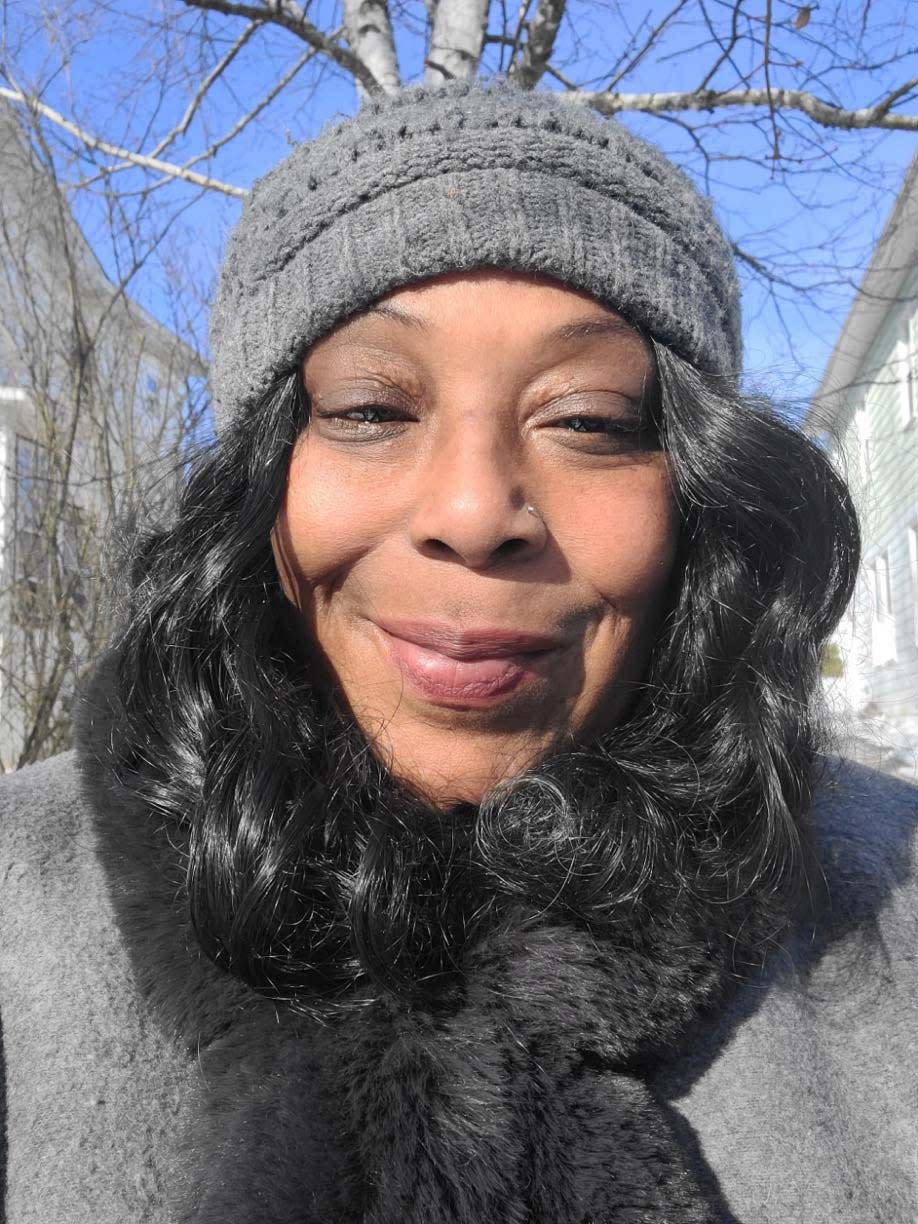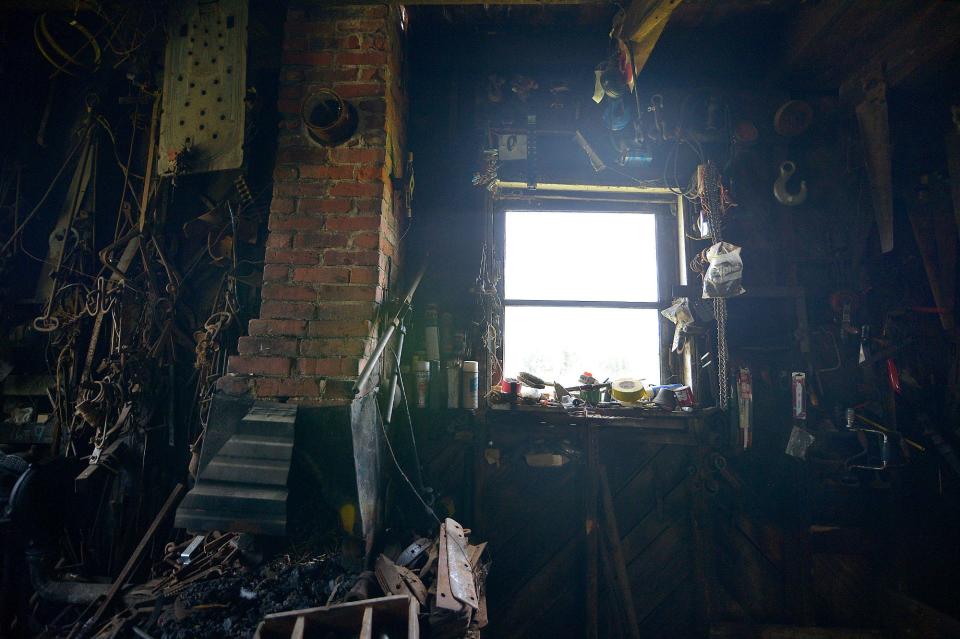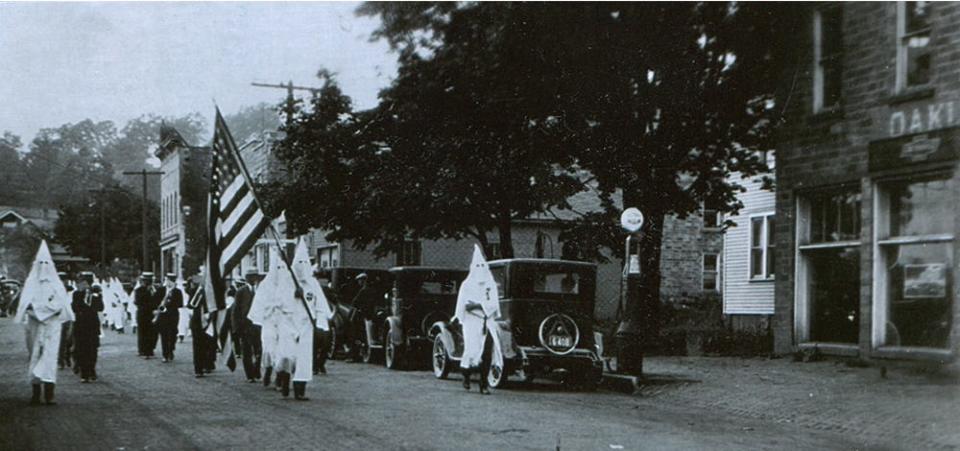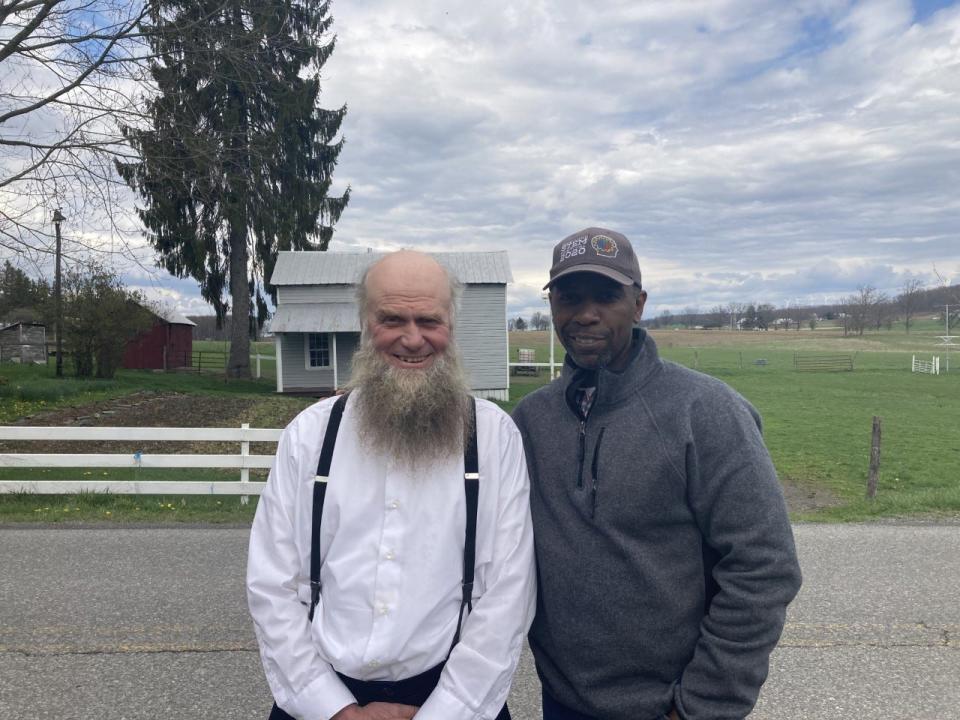In a rural Maryland community, a historic Black church brings a reckoning over racist history
Kate Smith feels something sacred when she steps inside this humble little shed on a farm in western Maryland.
A layer of white paint has mostly chipped off the wooden building's exterior. Piles of old tools sit in the grass nearby and a farm dog named Snookie lazes in the shade, tired out from chasing a tractor through fresh-cut fields of hay.
Smith gazes up at the old building with reverence, speaking in a hushed tone.

"It was once a sanctuary," she says. "It was once a safe place. A haven for folks."
A brown sign next to the building elaborates: "The only African American church in Garrett County. Circa 1900-1920s."
Once known as Bethel African Methodist Episcopal Church, or Bethel AME, the building served as the house of worship for a small Black community that lived in Garrett County around the turn of the 20th century.
That community disappeared almost entirely in the span of a few short decades. By 1935, the church had been removed from its prominent spot in Oakland, Maryland, to the Amish farm where it sits today.
Smith, 53, one of Garrett County’s few Black residents, is trying to solve something of a mystery: What happened to the church all those years ago? And what became of the Black homemakers, farmers and children who made this rugged country their home?

Smith and a small coalition of Garrett Countians are working to restore the church and move it to a new location in Mountain Lake Park, a small town adjacent to Oakland, where it will serve as a historical marker and learning center dedicated to the history of the county’s Black residents.
The project gained steam last year as the nation roiled with protests after the death of George Floyd in Minneapolis.
Garrett County is living out that reckoning in miniature, as a few members of a mostly white community, eager to forge a better future, grapple with their home’s history of racism.
More than 100 people recently started a new NAACP chapter in Garrett County, making it the last county in Maryland to form a branch of the civil rights organization.
The church project, which will be one of the new chapter's first initiatives, offers a window into conversations about race happening across the country — and into just how difficult and painful those conversations can be in places where racism has festered for generations.
A 'SHAMEFUL' REPUTATION
Smith moved to Garrett County in 2016, relocating from North Carolina after she separated from her husband.
Standing in the bright sunlight, she holds a folder full of historical documents but doesn't need to refer to them. She can explain the church's history, much of which she researched herself, from memory.
Smith speaks quietly, but her steady determination is obvious. It has served her well in Garrett County.
“I was not planning to stay this long, but I fell in love with the beauty and I do have a small group of very wonderful friends,” she said.
Garrett County is known for its natural beauty — expansive views of rolling farmland are interrupted only by the Allegheny Mountains, which sweep through the entire region.

Deep Creek Lake, long a getaway destination for city dwellers seeking a break from the summer heat and humidity, sends creeping fingers in all directions from the center of the county.
Seated just below the Mason-Dixon line, Garrett County is a deeply conservative, rural enclave in western Maryland, a state that is better known for its Democratic-controlled metropolitan areas.
Today, just over 1% of Garrett County's population is Black, according to U.S. Census data, making it an outlier in a state that has the largest proportion of Black residents outside the South.
Mountain Lake Park Mayor Don Sincell addressed the issue of racism in a video he posted online a few weeks after Floyd’s death at the hands of police.
“For well over a century Garrett County has had the reputation of being racist, of being a place where Black Americans were strongly encouraged to avoid, if they knew what was good for them,” Sincell said, standing in a room decked with American and Maryland flags.
“That is an absolutely shameful, embarrassing reputation for those who call this home,” he said.
Smith lives the effects of that reputation. She struggled to find a job that matched her qualifications. A human resources representative once told her the community would not be able to accept her in a management position.
“I don’t feel always welcome everywhere I go,” Smith said.
In 2019, Smith won a seat on Oakland Town Council by two votes. Only 149 people cast votes in that race.
She decided not to run for reelection this year after she received custody of her young grandson. Now she struggles with loneliness; the isolation of the COVID-19 pandemic left her feeling shaken and she can’t always find someone to watch her grandson if she wants some time to herself.
But she turned her feelings into fuel. She has spent years intensively researching the history of African Americans in Garrett County, collecting evidence that she does, in fact, belong there.
“I refuse to let people tell me where I can and cannot live,” she said.
STORIES TOLD IN 'HUSHED TONES'
Census records from 1900 render the lives of Garrett County’s Black residents into single lines of tight, curling script.
Rows and rows of white residents, their race noted with a pointy W, are occasionally interrupted with Bs, for Black. Census takers also noted each person's occupation.
“Farmer”
“Wash woman”
“Barber”
“Attends school”
Smith and other local historians have tried to use records like these to piece together the story of Garrett County’s Black residents and the church in Oakland that served as their spiritual home.
Historical racism looms over their efforts, making it more difficult to find documentation and learn the truth from the few people still alive who might hold relevant memories.
“A lot of these are stories told in hushed tones,” said Paul Durham, a former park ranger who has studied the history of slavery and the Underground Railroad in Garrett County.
“There was probably a time in the county where you didn’t talk about that,” he said. “You don’t talk about these dark things in our past, and they got tossed into the memory hole.”
Here's some of the history of Bethel AME that researchers have been able to glean:

A group of trustees bought land for the church in 1895 for $150. Though one historical map identifies a small, rough-hewn “colored” church on that land as early as 1886, it seems a sturdier building took shape there about a decade later.
The Rev. George Claudius Taylor is credited with building the Oakland church in a 1916 AME reference book. He traveled widely, restoring and rescuing ailing AME churches in multiple states.
Seated at Fifth and High streets in Oakland, the little church looked out over a graveyard on a hillside. Bethel AME stood at that corner until the mid-1930s.
Other details from the building’s life are blurred, but records from that time hint that it was home to a vibrant community of worshippers. For a few decades, there were between 100 and 200 Black residents living in Garrett County.
In 1910, The Republican — a local newspaper that Sincell’s family owned for generations — advertised a “minstrel show” that the Black residents of Oakland and Mountain Lake Park would put on to benefit their church.
“The program will consist of music, character sketches and dialogues and the entertainment will be very enjoyable to everyone,” the advertisement read. “During the entertainment refreshments will be served. Admission, adults, 25 cents; children, 10 cents.”

An AME church leader visited Oakland in 1924 and noted that things were in “splendid condition,” according to the Baltimore Afro-American.
Around 1927, Smith said, the Afro-American stopped printing notices about church services at Bethel.
"There was no more talk of Oakland Bethel," Smith said.
'NO COLORED PEOPLE LIVE IN GARRETT COUNTY'
Maryland held an unusual position during the Civil War. It was a slave state, and deeply divided in its loyalties, but did not join the South.
Garrett County didn’t even exist until after the war. It is the youngest jurisdiction in Maryland, named in 1872 for the railroad magnate John W. Garrett — a pragmatic businessman who, before the Civil War, owned one enslaved person.
Though the region’s climate didn’t support some of the major crops that propped up the South and its slave economy, some enslavers did live in Western Maryland before abolition. Maryland narrowly voted to end slavery in 1864, not long before the federal government did.

Oakland at one point had a “considerable" Black population, according to a 1949 centennial commission that issued a report on the town’s history.
Slave-owning settlers brought their slaves with them, the commission wrote; when freed, most former slaves "left the plantations to live in the cities, or where the winters were not so cold."
By the 1930 census, there were about two dozen Black residents in Garrett County. The 1940 census recorded only five, according to the Western Maryland Historical Library.
In the 1949 report, the Oakland Centennial Commission declared, “No colored people live in Garrett County now.”
The apocryphal explanation that Black residents left to escape Garrett County’s cold winters became something of a joke among white residents, the Baltimore Sun reported in 2001, offering a convenient out to anyone who wanted to ignore the more uncomfortable reasons for their disappearance.
What really happened? That’s the question that Smith and others hope to answer with their historical research.
'READ AND RUN'
The group working to restore the church has several theories about the disappearance of the Black community.
As the railroad became less important as a form of transportation, Garrett County’s summer tourism industry quieted and supported fewer jobs. Economic factors likely played a role, researchers reason, in pushing Black residents to other places in search of work.
But there is also a more sinister possible explanation. By the 1920s, an ascendant Ku Klux Klan was gaining popularity across the country.
Some of the local historians’ findings portray a campaign of racial terror in Garrett County and the surrounding area.
One photograph from the era shows hooded Klansmen marching through downtown Oakland.

East of Oakland, in a small town bordering West Virginia, the KKK took out an ad in the local high school’s yearbook in 1926.
In the next county to the east, the “Women of the Ku Klux Klan” held a field day in 1925 that was billed as “the biggest event in the history of Klancraft.”
One elderly neighbor told Durham that he saw crosses burning on a cemetery hill in Oakland, just below where the church stood, as a child.
The Harvard historian Henry Louis Gates Jr., who grew up 25 miles from Oakland in West Virginia, remembered the town in his memoir as a place where the people “really and truly” hated African Americans.
Chillingly, Gates’ father claimed that a sign in Oakland warned Black people (using a racial slur) to “read and run. And if you can’t read, run anyway.”
Gates' memoir also describes a failed lynching in Oakland that nearly took the life of a Black saxophone player. A representative for Gates said he was not available to comment for this story.

The passages from his book contributed to the widespread belief that Oakland, and possibly all of Garrett County, were "sundown towns" that forbid Black people from being there after dark and effectively created all-white communities.
Oakland and Garrett County are both listed as "probable" sundown towns in an online registry that tries to confirm where these communities existed using census records.
Durham is working to learn more about the disappearance of Garrett County's Black community for a future article documenting that history.
“Each of these little stories is pieces of a puzzle, and you start putting it together,” Durham said.
“With all these forces around you, you choose to move. It probably was a combination of all of the above," he said. "And if you were white in Garrett County, you would not have experienced all those forces that were making your life tough.”
A BLACKSMITH'S STORIES
By 1935, a newspaper in nearby Cumberland reported that Bethel AME was abandoned. A man named Simon Swartzentruber would use the lumber to erect a repair shop on his farm.
All these years later, that farm is where the church still stands. Swartzentruber’s grandson, Samuel Yoder, lives there now and works the land.
Yoder speaks at a deliberate pace, pausing often. He considers himself trilingual, in a sense, because he speaks English, a German dialect used by the Amish, and the more formal high German when preparing sermons.
He remembers working with his grandfather in the old church, hearing stories of how the building came to be on their farm.
His grandfather used to recall the day he went into town to start dismantling the church’s steeple. Yoder can retell the story, though he doesn’t remember every detail.
A Black man approached Swartzentruber and shouted “Come down, Mr. Amish man, come down from that church. That is my church,” Yoder recounted. “You may not do that to my church.”
Swartzentruber went to City Hall to confirm his ownership of the building, and then continued dismantling it. No one tried to stop him after that day, Yoder said.
“Maybe there was still one person that prayed to the almighty God in that building,” Yoder said.
Exactly what happened to the church during those transitional years remains unclear. Was the building still being used for worship on a smaller scale as the Black community shrank? What pushed the church trustees to sell the property in 1934?

Smith believes the man who tried to stop Swartzentruber was the pastor of the church. And she attributes the building’s removal to the same “racism and hate” that she considers responsible for driving Black residents out of Garrett County.
Yoder also thinks it's possible that churchgoers may have been forced out somehow. His grandfather used to mention that town officials were trying to build a high school on the property where Bethel stood and wanted the church gone quickly.
“I would suspect, by the stories, that there was a little bit of backhandedness going on,” he said.
Yoder wonders if his grandfather felt sympathy for the man who tried to intervene in the church's removal. The Amish, he reasons, were considered outsiders then, too.
But Swartzentruber needed a workshop for blacksmithing, so he took the building apart in large pieces and reassembled it on his farm.
Today, the building looks out on 170 acres where Yoder grows corn, soybeans and other cash crops. Yoder was born there. The farm is all he knows.
He agreed to sell the old church for $7,500 last year so that it could be restored. The Town Council in Mountain Lake Park voted unanimously to buy the building.
Yoder is working to clear out his grandfather's old blacksmithing equipment so the church can be transferred to Mountain Lake Park.
A NEW CHAPTER
With their county's history in mind and Floyd's death acting as a spark, a group of Garrett Countians began working to form a new chapter of the NAACP last year.
One of Smith’s friends, Daphne Gooding, serves as the organization’s president. She didn’t realize how bad racism was in her county until she started hearing Smith’s stories about living there — the odd looks at the store, the whispers in restaurants.
“I didn’t like what I was hearing,” Gooding said. “It was so bad, how she was being treated in a lot of different situations, that we wanted to do something about it.”
Gooding, Smith, and a group of supporters got to work signing up enough members to charter the Garrett County NAACP branch. Within a few weeks, they had 120 members — 20 more than the organization requires for new branches.
Gooding, like most of the new branch's members, is white. Only a dozen or so members of the group are Black.

Smith is the organization's vice president. She worried that she would attract backlash if she served as president. But there’s another reason, too.
"I would rather not be the president," she said, "because in order for white people to stop racism, they have to hear it from another white person."
The group’s members see their mostly white membership as a callback to the NAACP’s founding. The NAACP began in 1909 with mostly white leaders who were interested in improving civil rights for African Americans (though W.E.B. Du Bois was one of the organization’s first officers).
“We need to discover and I guess empathetically understand how bad things have been and continue to be,” Gooding said. “You can’t do that by running out and trying to fix it. We’ve got to listen, we’ve got to learn, we’ve got to be allies.”
The new chapter makes Garrett County the last county in Maryland to form an NAACP branch. Restoring Bethel AME will be one of the group’s first projects.
As mayor of Mountain Lake Park, Sincell has played a key role in negotiating the sale of the building and planning its move. Durham is the NAACP branch's secretary.
Willie Flowers, the president of the NAACP Maryland State Conference, was excited when the Garrett County group reached out about starting their branch.
“It needed to happen,” he said. “It was the last holdout.”
He’s particularly proud of Smith, who brought all these people together during the pandemic.

“She’s an organizer, she’s everything. She’s a servant-leader, she’s committed,” Flowers said.
But even a determined leader like Smith isn’t immune to the continuing racism in the place she calls home.
She grew more and more uncomfortable during the four years of Donald Trump’s presidency. She observed with horror that some of her fellow county residents were upset when Derek Chauvin, the police officer who kneeled on George Floyd’s neck for more than eight minutes, was convicted of murder in April.
Like the Black residents who lived here a century ago, Smith faced an impossible choice.
She enjoys the natural beauty and her friendships in Garrett County. But could she stay in a place where she feels increasingly unsafe?
Smith leaned forward, eyes welling with tears, and admitted quietly: “I don't even know if I want to be here anymore.”
A few weeks later, though, she'd made a decision. A man at a grocery store made a racist comment directed at her grandson, she said. It was too much.
"I'm dying while still living," Smith said. "I fought, and I'm sick of fighting."
By the end of August, she'll move away from Garrett County for good.
Follow Madeleine O'Neill on Twitter: @maddioneill.
This article originally appeared on USA TODAY NETWORK: A historic Black church brings a reckoning in rural Maryland community
